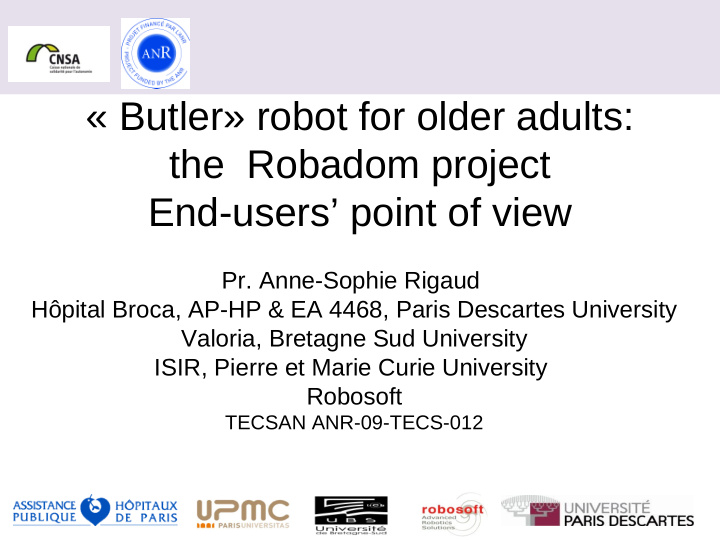



« Butler» robot for older adults: the Robadom project End-users’ point of view Pr. Anne-Sophie Rigaud Hôpital Broca, AP-HP & EA 4468, Paris Descartes University Valoria, Bretagne Sud University ISIR, Pierre et Marie Curie University Robosoft TECSAN ANR-09-TECS-012
Assistance Publique-Hôpitaux de Paris University Paris Descartes- LUSAGE Lab Fundings France Alzheimer (2009- 2011)
Our aims • Technologies matching the needs of older adults with cognitive impairment • Provide therapy and cognitive prothesis • Increase social link • Train carers and alleviate their burden • Facilitate life at home
Social robots: state of the art • Robots for older adults: – Assistant, companion (Sharkey and Sharkey, 2010) – Facilitating ADL: Robocare, Mobiserv, Domeo, CompanionAble, QuoVadis, Robadom
Robadom: Objective • Develop an assistant and companion robot for older adults with MCI Needs and specifications, Methods interaction and Questionnair scenarii Robot Multimodal es Focus perception prototyp groups interaction e Procedures Robot assessment Neuropsychological Usability and assessments acceptability Behavioral analysis Interactio n
Theorical model • Acceptance and use • Interactions with robots Ease to use First interaction Visceral reaction Perceived Perceived enjoyment usefulness Usage Social signals Intention Interaction to use Long term experience Social structures Use Heerink & al 2010 Young & al 2010
End-users needs •22 older adults •MMSE = 19-30 •Age = 66-88 •Questionnaires •Focus groups • Difficulties: memory impairment, somatic diseases & loneliness • Interest for services: cognitive stimulation, assistance in finding small items, appointement reminder, visiocall • No expression of need for help in ADL • Fear of stigmatization and intrusion (Valkila et al 2009)
Perceived enjoyment and usefulness Ease to use
Usability of services 17 MCI P (t- N MCI test) 15 NX 383,7 406,7 15 MCI Total time 5 8 NS Errors in use 6,75 8,78 NS Aids 3,75 6,44 NS
Usability - Acceptance Cuisine WC V V T T •Services Interest + wish of other services linked to hobbies •Companion Interest + other modalities of expression, emotions •End-users Useful for other people not for themselves Neven 2009
Robot choice by end-users
End-users robots choices •15 older adults •MMSE = 22-30 •Age = 65-85 •Questionnaires •Focus groups Furniture Machine 26% 31% Animal 18% Humanoide 25%
Choices In Robots h 4 3 1 2 • Small, shiny, soft, plastic material, up-to-date design • Round shape, familiar item : teapot
Designed robot camer Expression a of emotions Movemen ts of wings Drawn by patients Robosoft
Interaction Expressions, emotions
Objective and method • How did 20 older and 23 young adults perceive affects from expressions of the Nabaztag? • 27 expressions of Nabaztag 3 colours: green, blue, and red 3 ear positions: horizontal, vertical and asymmetric 3 levels of speed of light blinking: rapid, slow and continuous)
Procedure • Subjects categorized each of the 27 expressions of Nabaztag into one of the 8 affects in term of adjective (surprised, enthusiastic, joyful, calm, inactive, bored, sad and frustrated). • These items were chosen based on the circumplex model of affects Russell, J.A.,1980. A circumplex model of affect. Journal of Personality and Social Psychology: 39, 1161–1178
Colours : perception of affects Young adults Older adults surprised surprised 50 50 40 40 frustrated * enthusiastic frustrated * enthusiastic * 30 30 20 20 10 10 blue blue sad * 0 joyful * red sad 0 joyful red green green bored * calm * bored calm * inactive inactive • For the younger adults, colors were useful clues to help interpret affects. • Blue mostly related to calmness & red to frustration
Ear position: perception of affects Young adults Older adults surprised * 60 surprised 50 50 frustrated enthusiastic * 40 40 frustrated enthusiastic * 30 30 20 20 10 vertical 10 vertical sad 0 joyful * asymetric sad * 0 joyful * asymetric horizontal horizontal bored calm bored * calm * inactive inactive • The older adults used ear positions as clues to interpret affects. • Vertical ear position mostly related to positive affects, such as joy and enthusiasm.
Effect of physical embodiment on social interactions •Older adult’s interaction with a robot, a virtual agent and a laptop while playing a game of trivia? •19 older adults’ preferences: Laptop>robot>avatar
Discussion • Acceptance and use • Interactions with robots Ease to use First interaction Visceral reaction Perceived Perceived enjoyment usefulness Usage Appropriation? Interactions Social signals Intention to use Long term experience Social structures Use
Main points: end-users and robots • Tailor robots and services to end-users needs • Develop tools to test end-users’acceptance, pleasure and engagement • Test at home and long term experience • Respect confidentiality and consent • Ensure liability and safety of use • Ensure ethical reflexion – Safety in ADL versus intrusion – Companion versus loss of humanity – Innovation versus stigmatization
LUSAGE LAB EA 4468 Thanks to • Dominique Duhaut, Brigitte Le Pevedic, Valoria, Bretagne Sud University • Mohamed Chetouani, ISIR, Pierre et Marie Curie University • Vincent Dupourque, Robosoft • ANR-TECSAN
Recommend
More recommend